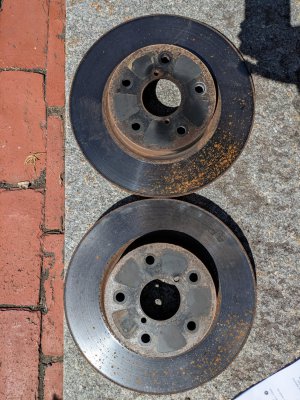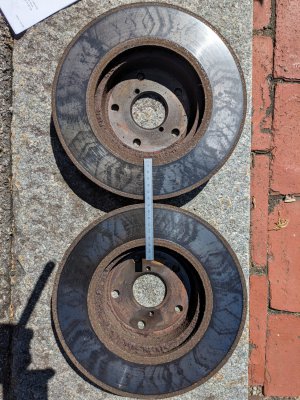- Joined
- Nov 25, 2015
- Messages
- 8,409
do people really care about their own lives? Not all.


My brakes don't look like that! My tires are nowhere like that!!!! Wow.do people really care about their own lives? Not all.
If it isn't a vented rotor you can take a little more off one side or the other...Brake rotor wear limit is 1mm, which is .020 per side. Some manufacturers (OEMs) allow 2mm, so it does depend on your car.
I never said anything concerning the validity of the assumption....do people really care about their own lives? Not all.
I'm thinking that this is what happened. "I know it's no good when I see it" kind of judgement, but there's nothing objective. Thinking of calling DMV. They may simply say, "we give wide latitude to certified inspectors". If so, I'll ask what prevents "self serving" rejection? How are self serving inspectors reprimanded or removed? Or maybe they will tell me something useful, it could happen. Well instead of blabbing here, I sent a message to my state DMV asking about this, and if this is a failure, what line number does it fail under. I didn't mention the dealer, there's no need to at this point. Just want to get the DMV's guidance on "rust rings", what can pass and what should fail. The regulations are unclear to me, think they should be clear to everyone.Subjective tests suck. I failed an inspection because my signal lamps were "the wrong color yellow". I said they looked amber to me. I asked to see a color card or for a Pantone or RAL Code, something conclusive. Nope. Failed and had to come back the next day. Another time they told me my front side windows were tinted. The hell they are, I said, and vigorously took my car key to the bare glass on the inside. No apologies issued, just a single cross-armed grunt from the full cadre of inspectors. There is no fault if a fault can't be compared to a verifiable standard. Except at vehicle inspection...
Don't be surprised if your answer from the DMV involves waking up with a bloody horse head in bed next to you.I'm thinking that this is what happened. "I know it's no good when I see it" kind of judgement, but there's nothing objective. Thinking of calling DMV. They may simply say, "we give wide latitude to certified inspectors". If so, I'll ask what prevents "self serving" rejection? How are self serving inspectors reprimanded or removed? Or maybe they will tell me something useful, it could happen. Well instead of blabbing here, I sent a message to my state DMV asking about this, and if this is a failure, what line number does it fail under. I didn't mention the dealer, there's no need to at this point. Just want to get the DMV's guidance on "rust rings", what can pass and what should fail. The regulations are unclear to me, think they should be clear to everyone.
I'm out nearly $600 for this unplanned escapade. Also have to go back to "the scene of the crime" to get reinspected. Hah, hah, that's if my car will move. Haven't driven it since Wednesday.
As for rotors - mine are ventilated. As manufactured they measure 28mm thick. Mine measured 27.68mm, the spec limit is 26mm. Barely worn.
